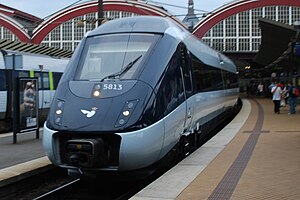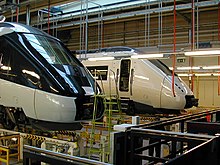DSB MG
| DSB MG | |
|---|---|
|
IC4 MG 5613 in Københavns Hovedbanegård
|
|
| Numbering: | 5601-5608 5610-5683 |
| Number: | 83 |
| Manufacturer: | AnsaldoBreda |
| Year of construction (s): | from 2005 |
| Gauge : | 1435 mm ( standard gauge ) |
| Length: | 86 m |
| Width: | 3,150 mm |
| Empty mass: | 160 t |
| Top speed: | 200 km / h |
| Installed capacity: | 2,240 kW |
| Motor type: | 4 motors (underfloor) |
| Train control : | ATC |
| Seats: | 208 |
| Classes : | 2 |
The DSB MG is a series of four-part diesel railcars from AnsaldoBreda for long-distance transport operated by the Danish railway company Danske Statsbaner ( DSB ). The train is also known as type IC4 . There were already several complications during delivery and operation, the trains are considered to be defective.
vehicles
The vehicles each consist of two power cars of the DSB series MG and one intermediate car each of the DSB series FG and one low-floor intermediate car of the DSB series FH . Each multiple unit has 187 seats in two classes , plus 21 folding seats . Up to four of the four-part units can be coupled together to form a train.
history
After a Europe-wide tender , DSB ordered a total of 83 four-part units from the manufacturer AnsaldoBreda in December 2000 . The MG trains are to replace the DSB MF in long-distance traffic. The IC3 units will in turn replace locomotive-hauled trains in regional traffic.
The first trains were to be delivered in April 2003 and put into service from January 2004 to 2006. Technical problems at a supplier canceled this schedule for the first time. In the summer of 2007, the first trains were finally in the approval process. As a temporary replacement, rented ICE-TDs are used in traffic to Germany .
In mid-2008, the DSB gave the manufacturer an ultimatum. By May 2009, at least 14 trains must meet the requirements for unrestricted approval. In addition, at least one unit must fully comply with the contractually agreed conditions. Should the manufacturer fail to do so, DSB wanted to withdraw from the 670 million euro contract. Until mid-2008, the trains did not get beyond the trial operation and individual trips to travel. The multiple control causes problems in particular .
On December 1, 2008, DSB started passenger service with the first multiple units. The diesel multiple units in the Aarhus area had been tested since August 7, 2008 . By the beginning of December 2008, five multiple units had been handed over to DSB.
AnsaldoBreda managed to deliver the required 14 trains by May 2009, so that DSB did not withdraw from the contract. However, all 14 trains had to return to Italy again to carry out mechanical changes and a software update.
In May 20, 2009 DSB reached an agreement with AnsaldoBreda that 83 IC4 and 23 IC2 are to be delivered by 2012 and that AnsaldoBreda has to pay a severance payment of 2.25 billion DKK (EUR 300 million), which DSB for The following is used:
- DKK 0.8 billion (EUR 107 million) for the completion and improvement of trains in a workshop in East Jutland
- DKK 0.7 billion (EUR 94 million) for the rental of replacement trains (45 double-decker cars at Railpool and three ICE-TD diesel multiple units )
- DKK 0.5 billion (EUR 67 million) for an action program to improve punctuality in long-distance and regional transport
- DKK 0.25 billion (EUR 34 million) was disbursed in 2005 and has therefore already been used.
The compensation payments that have to be paid for the delivery that is more than five years late make up almost half of the order value. Series production had meanwhile been relocated from Pistoia to Milan.
Another train was delivered in the second half of 2009. All 83 should be delivered by autumn 2012. If the delivery of eight trains is delayed by more than six months, the DSB can withdraw from the contract.
In the course of the operational problems with the multiple units, DSB were forced to continue to use the polluting locomotives of the ME series in the area of Copenhagen in 2010 . The pollution from the diesel locomotives far exceeded the emissions for trucks in Copenhagen. This is why EMD has procured so-called emission kits for 20 of the existing locomotives in the United States, which reduce nitrogen oxide (NOx) pollution by around 34 percent and soot (particulate) pollution by 37 percent. The amount of unburned oil in the exhaust gas is also reduced. After the conversion, the locomotives meet the standard of the American environmental authority EPA Tier 0 Regulation 40 CFR Part 20 .
On May 4, 2011, DSB stopped the further delivery of IC4 after the trains were severely defective and only a small number of the trains delivered could be used. DSB has expanded workshop capacities in Denmark in order to be able to rework the trains itself.
On November 15, 2011, all machine guns were shut down by DSB until further notice and replaced by other vehicles. Previously, on November 4, 2011 in Høje Taastrup and on November 7, 2011 in Marslev Sogn, two IC4s had passed signals indicating stop due to problems with the braking technology. The Danish investigative authorities found similarities between the two incidents, whereupon the trains were parked for safety reasons pending clarification of the facts.
On July 11, 2012, DSB resumed passenger services between Aarhus and Esbjerg with the first IC4 trains. The section between Aarhus and Aalborg followed on August 13, 2012.
After it was unclear whether the procurement of a total of 74 trains would be realistic by 2019, a study was commissioned. In 2015, it came to the conclusion that procurement was achievable.
Shutdowns and recommissioning
The IC2 train sets did not meet the requirements that are required for stable use in rail traffic. These were only used to a very limited extent. In future, the focus will be on the operational safety of the IC4 sets, which cannot be dispensed with in the medium term. In order to reduce the dependency on the unsafe train sets, investments such as the procurement of new electric locomotives were planned. All 23 IC2 sets and 5 MG sets were shut down with effect from 23 August 2016.
With the shutdown of the IC2 trains, a depreciation of 588 million crowns was added to the balance sheet. At the same time, five IC4 sets that were no longer needed and also parked were written off with 85 million crowns.
In December 2016, the trains were removed from long-distance traffic and assigned to regional traffic until they were withdrawn.
On March 7, 2017, the DSB completely ceased traffic with the multiple units until further notice. This decision follows an incident that day when a hydraulic pump failed on a train near Hedehusene . This was the second failure in two weeks. After a thorough analysis, it will be decided whether the railcars will be put back into operation.
On March 24, 2017, the DSB decided to gradually re-use the multiple units from March 27. As a first step, express trains ran again between Aarhus and Fredericia from that day. From March 29, the regional train connections between Aarhus, Fredericia and Esbjerg, as well as the morning express trains from Aarhus and Odense to Copenhagen, will resume. A temporary solution has been created to ensure that the loose hydraulic pump does not pose a safety hazard. They were allowed to be monitored, and the train units are checked more frequently.
Whereabouts
The MG 5607, 5608 and 5612–14 sets, which were already parked between 2013 and 2016 and then written off at the end of 2016, were scrapped in Randers in 2017.
Worth mentioning
Italian Prime Minister Silvio Berlusconi has said Libyan revolutionary leader Muammar Gaddafi on the 40th anniversary of his revolution in 2010 as a state gift for a salon - railcars converted IC4 from the production of these trains for the Danish State Railways via suitable. It was a four-part unit with two saloon cars and a conference car. The equipment included an Italian espresso machine and a jogging treadmill. The diesel railcar is designed for speeds of up to 200 km / h. Since the only drivable route in Libya - as a test route near Tripoli - is only a five-kilometer section of the Ras Ejder – Sirt railway line , it was never used. But he probably survived the civil war unscathed.
The train can be seen on a satellite image from November 10, 2013 by Google Earth ( IC4 train from AnsaldoBreda in Libya ).
Individual evidence
- ↑ a b c d Message IC4 for the DPO . In: Eisenbahn-Revue International , issue 2/2001, ISSN 1421-2811 , p. 84.
- ↑ a b DSB stops IC4 delivery , May 4, 2011
- ^ A b c Peter Nørregaard Jespersen: The success of the IC3 . In: European Railway Review . Vol. 13, No. 3, 2007, ISSN 1351-1599 , pp. 29-31.
- ↑ a b Report of ultimatum due to IC4 . In: Eisenbahn-Revue International , July 2008 edition, ISSN 1421-2811 , p. 354
- ↑ DSB puts IC 4 into operation . In: Eurailpress.de (online report from December 2, 2008, accessed on September 13, 2016)
- ↑ a b Press release of the DSB: Status pr. May 20, 2009 for IC4 and IC2 leverancerne ( Memento from June 30, 2011 in the Internet Archive ) (Danish; PDF; 76 kB)
- ↑ Birgitte Marfelt: DSB sender sine 14 IC4-tog tilbage til Italy. ( Memento from June 15, 2009 in the Internet Archive ) On Ingeniøren , June 12, 2009. (Danish)
- ↑ a b Message IC 4 “prematurely” . In: Eisenbahn-Revue International , Issue 5, 2010, ISSN 1421-2811 , p. 241
- ↑ Nicolai Østergaard: IC4-forsinkelse tvinger DSB til at modernized ME-lokomotiver. In: Ingeniøren. Ing.dk, January 19, 2010, accessed September 16, 2016 (Danish).
- ↑ Denmark: DSB takes IC4 out of operation after braking problems. Eurailpress, November 18, 2011, accessed September 13, 2016 .
- ↑ IC4-tog havde mekaniker med on jomfrurejse from Aarhus to Esbjerg | Danish magazine Ingeniøren ( Memento from October 17, 2012 in the Internet Archive )
- ↑ IC4 indsættes gradvist | Danske Statsbaner DSB
- ↑ IC4 project needs more resources . In: Railway Gazette International . tape 171 , no. 1 , 2015, ISSN 0373-5346 , p. 22 f .
- ↑ Results for 1. halvår blev et underskud for skat på 447 million. kr. Further information on IC2-flåden and 5 IC4-togsæt. dsb.dk, 23 August 2016, accessed on 15 September 2016 (Danish).
- ^ Nanna C. Pedersen: Pump gik løs: DSB indstiller al IC4-kørsel. ekstrabladet.dk, March 7, 2017, accessed March 7, 2017 (Danish).
- ↑ DSB indstiller passagerdrift med IC4 indtil videre. dsb.dk, March 7, 2017, accessed March 7, 2017 (Danish).
- ↑ IC4 genindsættes i passagerdrift. dsb.dk, March 24, 2017, accessed on March 27, 2017 (Danish).
- ↑ DSB IC4 - MG. In: jernbanen.dk. Retrieved November 8, 2018 (Danish).
- ↑ jst: Libya becomes a railroad country. In: Eisenbahn-Revue International. 4/2011, p. 173; Walter Rothschild: Libya. In: HaRakevet. 24/1 (March 2011), p. 19.
- ↑ jst: Libya becomes a railroad country. In: Eisenbahn-Revue International. 4/2011, p. 173.
- ↑ jst: Libyan IC4 to Denmark? . In: Eisenbahn-Revue 5/2013, p. 240; Nikolaj Vraa: Fandt DSB's forsvundne IC4-tog i Libya . In: Ekstrabladet v. 21st March 2013.


